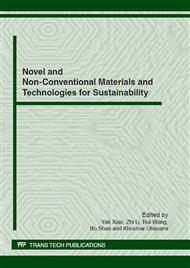p.887
p.892
p.897
p.904
p.910
p.915
p.919
p.928
p.932
Application Research on the New GFRP Members Based Modified Behavior Used in Building
Abstract:
Glass fiber reinforced plastics (GFRP) is an immensely versatile material which combines lightweight with inherent strength. For the properties of sustainability, energy efficiency and reduction of CO2 of GFRP, they can be used in green building as a kind of the energy-efficient and environment-friendly material instead of the conventional materials. Based on the less elastic modulus and lower wave-transparent properties of glass fiber reinforced plastics for unsaturated polyester resin (UPR-FRP), a new kind of glass fiber reinforced plastics based modified unsaturated polyester (MUPR-FRP) was put forward. This paper presents material behavior and technical process of the new MUPR-FRP. For the modified property, the MUPR-FRP members may have the well superiority compare with the steel and the concrete materials used in strengthening engineering and special loading resistance.
Info:
Periodical:
Pages:
910-914
Citation:
Online since:
June 2012
Authors:
Keywords:
Price:
Сopyright:
© 2012 Trans Tech Publications Ltd. All Rights Reserved
Share:
Citation:


